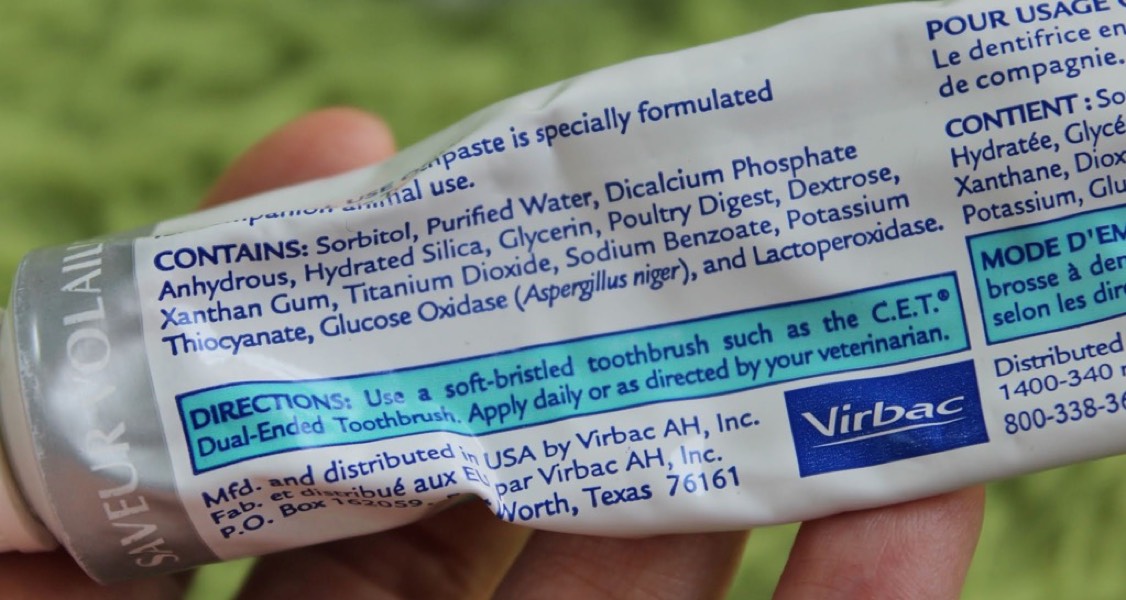Pet Dental Care Products 101: Flavors, Thickeners, and Preservatives
By: Ian Nicholson | Aug 15, 2022

As a responsible pet parent, you want dental formulas that support your furbaby’s oral health. While reading labels, you may see items you don’t recognize. What is dextrose? Why would cornstarch be present? What about sodium lauryl sulfate? This guide answers these and other questions about cat and dog dental care product ingredients.
How Do Manufacturers Flavor Pet Dental Care Formulas?
Manufacturers add flavorings to make their products appealing to pets. Some, such as poultry digest or mushroom extract, come from plant or animal sources. Dog formulas may also use peanut butter flavoring or vanillin, an organic compound that gives vanilla beans their taste. Some beef flavorings ae created by mixing starches with the amino acids isolated from beef.
Do Pet Dental Products Contain Sweeteners?
Some dog dental care items use sugars to enhance their flavor. Many common sweetener choices are derived from food sources:
- Sorbitol: sugar alcohol extracted from glucose
- Dextrose: a sweetener derived from corn or wheat
- Barley malt syrup: an unrefined sweetener made from sprouted and malted barley
- Brown rice syrup: created from cooked rice broken down by enzymes
- Stevia: a sweetener extracted from the leaves of the stevia plant
All these sugars vary in composition. Barley malt syrup consists of maltose and complex carbs. Brown rice syrup is sweet because of its glucose molecules. Stevia has no calories or carbohydrates but is around 200 times sweeter than table sugar thanks to its steviol glycoside molecules.
You may rarely see sodium saccharin, a water-soluble artificial sweetener. Sodium saccharine imparts a sugary, slightly metallic taste to human foods. This odorless white sugar substitute results from oxidizing ortho-toluene sulfonamide.
Most sweeteners in dog dental care formulas appear in minuscule amounts. Gastrointestinal upset may occur with excess consumption, but the tiny bit used to brush your dog’s teeth does not pose a significant risk. Because cats lack taste receptors for sugar, most manufacturers do not add sweeteners to feline dental care items.
How Do Pet Dental Care Products Retain Consistency?
Pet dental care items may be in paste, powder, gel, or liquid form. Many pet toothpaste varieties contain thickening agents. One example is glycerin, a transparent odorless sugar alcohol with a syrupy texture and a sweet flavor. Besides creating a paste-like consistency, glycerin prevents these products from drying out. Other thickeners may appear in cat and dog dental care product ingredients:
- Xanthan gum: a polysaccharide that acts as a thickening agent and stabilizer
- Guar gum: a gel-forming polysaccharide derived from guar beans
- Cornstarch: a starchy substance extracted from corn kernels
- Cellulose gum: a fiber derived from the cell walls of plants
Some pet toothpaste uses kaolin as a thickening agent. Kaolin is a soft white non-toxic mineral clay used to craft porcelain dinnerware. The Journal of Clinical Dentistry reported that kaolin polishes teeth and removes stains while being less abrasive than hydrated silica. Emulsifiers like sunflower lecithin prevent oil and water mixtures from separating.
Can Dental Care Products Contain Preservatives?
Some pet dental care formulas contain preservatives. Manufacturers may incorporate them to inhibit the growth of mold, yeast, and harmful bacteria. Typical preservatives include:
- Sodium benzoate: a sodium salt of benzoic acid
- Maltodextrin: a processed starch that also serves as a thickening agent
- Methylparaben: a preservative derived from parahydroxybenzoic acid
- Potassium sorbate: a salt formed from sorbic acid
- Citric acid: a preservative present in citrus foods
According to the United States Food and Drug Administration, these preservatives are Generally Recognized as Safe. In rarer cases, pet dental care items could have phosphoric acid or potassium hydroxide. Some brands include them to balance their products’ pH levels. While these substances may exist in tiny amounts, the ASPCA Poison Control Center and Merck Veterinary Manual advise that they’re toxic to dogs and cats in copious quantities.
What Other Ingredients Might Dental Care Items Contain?
Cat and dog dental care product ingredients may include food colorings such as Yellow 5 and Blue No. 1 to give their products a pleasing appearance. Some toothpaste contains titanium dioxide, which gives it creamy texture and white color. The European Food Safety Authority concluded in 2021 that titanium dioxide could no longer be safe for use as a food additive.
Some formulas incorporate sodium lauryl sulfate, a cleaning and foaming agent in some human bath and beauty products. Sodium lauryl sulfate is a surfactant that lowers surface tension for dirt and grease to slide off more easily. Some pet dental care products include it to help scrub away food particles. The American Chemistry Council notes that it could cause minor irritation in humans, cats, and dogs with sensitive skin.
A Better Understanding of Product Labels
Pet dental care formulas contain cleaning and breath freshening agents. They also have ingredients that contribute to their textures, colors, and flavors. Others extend shelf life and inhibit spoilage. You don’t need to become a chemist to buy dental care items for your pet. However, understanding what’s in these products can help you make the best choices for your furry friend.
Series Articles
- Pet Dental Care Products 101: What Pet Parents Should Know
- Pet Dental Care Products 101: Active Ingredients
- Pet Dental Care Products 101: Avoid These Ingredients
- Pet Dental Care Products 101: Decoding Product Claims


Disclaimer: healthcareforpets.com and its team of veterinarians and clinicians do not endorse any products, services, or recommended advice. All advice presented by our veterinarians, clinicians, tools, resources, etc is not meant to replace a regular physical exam and consultation with your primary veterinarian or other clinicians. We always encourage you to seek medical advice from your regular veterinarian.

